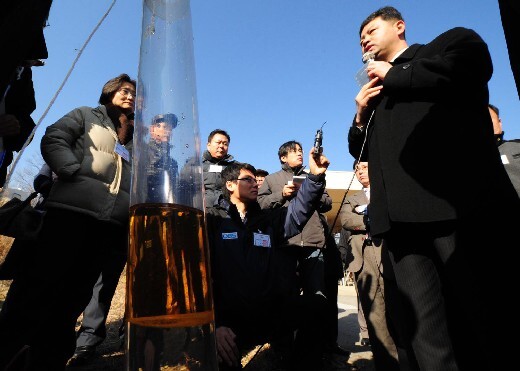hankyoreh
Links to other country sites 다른 나라 사이트 링크
Severe pollution levels detected at 13 U.S. bases scheduled for return to S. Korea

Severe pollution levels have been detected at 13 United States military bases nationwide scheduled to be returned to South Korea, with lead levels detected at more than 150 times the standard value at one U.S. firing range.
On Tuesday, The Hankyoreh obtained a copy of the results of pollution studies for 13 U.S. military bases scheduled for return to South Korea, showing that the lead levels of 15,200 parts per million detected at the Texas firing range in Paju, Gyeonggi Province, were more than 150 times the South Korean pollution cleanup standard of 100 parts per million. Copper levels were detected at 792 parts per million, 16 times the standard value of 50 parts per million. Zinc levels in the soil at the site of the Stanley highway expansion in Uijeongbu, Gyeonggi Province, were detected at 1,137 parts per million, far in excess of the standard level of 300 parts per million.
In an area of 13,760㎡ of land scheduled for return at a Defense Reutilization and Marketing Office in Busan’s Busanjin-gu, more than one third of the total area of 34,925㎡, lead was detected at 1,293 parts per million (13 times the standard), mercury at 243 parts per million (60 times) and zinc at 1,275 parts per million (3 times). The total petroleum hydrocarbon value, which shows the state of petroleum-related pollution, at 18,923 parts per million, reached some 37 times the standard value of 500 parts per million. The area is scheduled for return to South Korea in 2010.
These data are the result of a study of environmental pollution at U.S. military bases conducted by the U.S. military and the South Korean government. The U.S. military and the government’s Ministry of the Environment jointly conducted pollution surveys at 41 U.S. bases in connection with the bases’ cleanup costs, and the government has until now refused to announce the pollution status at 13 of the “sites scheduled for return.”
Experts predict that pollution levels and cleanup costs will increase by a large margin when the bases are actually returned to South Korea. Indeed, in the case of 23 bases returned in 2007, the initial committee study showed cleanup costs of only 119.7 billion won (US$84.6 million), but a Defense Ministry project estimate in August 2008 put them at 190.7 billion won, and a detailed study in November had the figure increasing to 320 billion won.
“Not only are the environmental problems severe at the 13 undisclosed bases, pollutants continue to be discharged even now in cases like the Yongsan Garrison and Camp Long in Wonju,” said Green Korea United Manager Hwang Min-hyeok. “If discussions for the bases’ return continue without any revision to the Status of Forces Agreement, at a level that can be agreed upon mutually with regard to the treatment levels and procedures, we will end up bearing expenses in the trillions of won,” Hwang added.
Please direct questions or comments to [englishhani@hani.co.kr]
Editorial・opinion
![[Column] Season 2 of special prosecutor probe may be coming to Korea soon [Column] Season 2 of special prosecutor probe may be coming to Korea soon](https://flexible.img.hani.co.kr/flexible/normal/500/300/imgdb/original/2024/0426/3317141030699447.jpg) [Column] Season 2 of special prosecutor probe may be coming to Korea soon
[Column] Season 2 of special prosecutor probe may be coming to Korea soon![[Column] Park Geun-hye déjà vu in Yoon Suk-yeol [Column] Park Geun-hye déjà vu in Yoon Suk-yeol](https://flexible.img.hani.co.kr/flexible/normal/500/300/imgdb/original/2024/0424/651713945113788.jpg) [Column] Park Geun-hye déjà vu in Yoon Suk-yeol
[Column] Park Geun-hye déjà vu in Yoon Suk-yeol- [Editorial] New weight of N. Korea’s nuclear threats makes dialogue all the more urgent
- [Guest essay] The real reason Korea’s new right wants to dub Rhee a founding father
- [Column] ‘Choson’: Is it time we start referring to N. Korea in its own terms?
- [Editorial] Japan’s rewriting of history with Korea has gone too far
- [Column] The president’s questionable capacity for dialogue
- [Column] Are chaebol firms just pizza pies for families to divvy up as they please?
- [Column] Has Korea, too, crossed the Rubicon on China?
- [Correspondent’s column] In Japan’s alliance with US, echoes of its past alliances with UK
Most viewed articles
- 1‘We must say no’: Seoul defense chief on Korean, USFK involvement in hypothetical Taiwan crisis
- 2Is Japan about to snatch control of Line messenger from Korea’s Naver?
- 3The dream K-drama boyfriend stealing hearts and screens in Japan
- 4Up-and-coming Indonesian group StarBe spills what it learned during K-pop training in Seoul
- 5S. Korea “monitoring developments” after report of secret Chinese police station in Seoul
- 6Division commander ordered troops to enter raging flood waters before Marine died, survivor says
- 7[Column] ‘Choson’: Is it time we start referring to N. Korea in its own terms?
- 8[Editorial] New weight of N. Korea’s nuclear threats makes dialogue all the more urgent
- 9Will NewJeans end up collateral damage in internal feud at K-pop juggernaut Hybe?
- 10‘Weddingflation’ breaks the bank for Korean couples-to-be